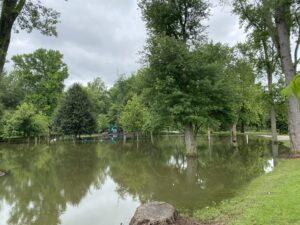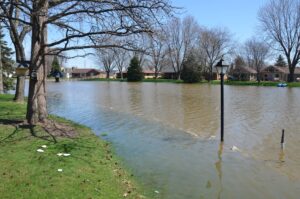Each year flooding from excessive precipitation occurs and create challenges for us and trees. The extent of damage from prolonged exposure to wet and waterlogged soils depends on the season and can have a legacy effect. Flood damage to trees can generally occur from prolonged saturated soils, physical damage from the flood waters and acute, extreme environmental conditions and tree reactivity.

Warm season flooding can create increased risks for tree survival.
Most trees and plants are not adaptable to flooded conditions and each species can have varying degrees of tolerance. Some species such as bald cypress, sycamore and even silver maples can tolerate prolonged wet conditions. These trees are known as riparian species and well-suited for wetter than normal conditions.
The physiological impacts on trees from flooding include poor aeration where water moves into the pore spaces that held gas such as oxygen, conditions unsuitable for plant growth. This leads to an accumulation of CO2, methane, and other gases, instead of good oxygen exchange above ground. Anaerobic conditions develop during flooding. This develops by anaerobic organisms replacing aerobic organisms. The results are denitrification, where bacteria remove the nitrates and nitrites from the soil, and reduction of available micronutrients such as manganese, iron and sulfur.
Flood damaged trees express symptoms such as reduced or no growth, poor leaf expansion, smaller leaves, chlorosis, and premature leaf drop with decline in growth being the primary issue. A reduction in root growth can be expected as well especially with the appearance of decay pathogens. Phytophthora is a root attacking fungi that tolerates low soil oxygen levels and stimulated by tree decline leading to root loss. This loss of root mass through the attack and decay leaves the tree prone to drought and windthrow with post-flooding conditions.

Dormant season floods are less damaging due to lack of leaves and colder water temperatures.
Flood damage on trees depends on many factors which include season, water quality and temperatures as well as the condition of the trees when they experience these damaging conditions. Flooding during the growing season is far more harmful than winter flooding. Warm season flooding magnifies the injury because of plant respiration and continuing water loss through the leaves. The higher the temperatures the faster the tree will feel the oxygen deficiency and the top of the tree will dehydrate. Just a little over two-weeks of submersion can lead to decline and death of some trees. Some species can tolerate up to 6 weeks of submersion.
The legacy effect of flooding is important to identify. Siltation is a concern to tree health as soil fill left behind from flooded waters can collect and deposit over roots systems. If the trees don’t respond with the formation of new root systems in these elevated locations, they will decline and die. Conversely, soil erosion can be a concern as some trees will be left with bare roots and exposed roots plates. This creates a poor anchorage system and leaves trees more susceptible to windthrow. Secondary pest problems are a concern as well. Due to the reduced tree vigor and changing growing conditions, opportunistic pests can become a problem for several years after the flooded conditions.
Post-flooding management practices are important to initiate quickly to reduce the impacts of flooding on trees, especially if these conditions occur during the growing season.
- Contact an ISA Certified Arborist to help with the assessment of tree survival and structural conditions which could present unacceptable risk levels. Expect trees to die suddenly, decline and die in the current year, or decline over the next few years.
- Conduct a soil test to determine if there are any elemental deficiencies from the prolonged wet conditions. Provide supplemental nutrition as indicated by the soil tests.
- After flooding recedes, apply a light dose of nitrogen, approximately 0.5 -2.0 pounds of nitrogen per 1,000 square feet. Very small amounts of calcium sulfate can be added to return sulfur to the soil, if indicated by the tests.
- After this application, do not fertilize with nitrogen again until after full leaf expansion in the next growing season. In each of the next three years, apply 2-4 pounds of nitrogen per 1,000 square feet.
- Reduce or refrain from any pruning that removes live green tissue. These leaves are needed for carbohydrate production and food supplies.
- Monitor for fungal and insect attacks on stressed trees and take informed action. Both the trees under attack and the surrounding trees may need rescue or preventative treatments.
For more information visit:
Indiana Arborist Association